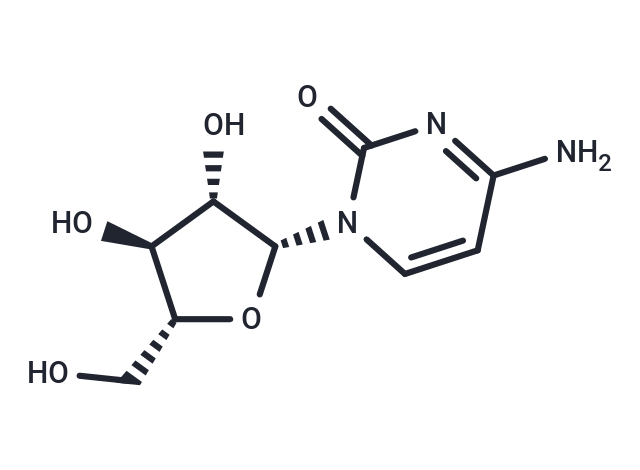Shopping Cart
- Remove All
 Your shopping cart is currently empty
Your shopping cart is currently empty

Cytarabine (Ara-C) is a nucleoside analog, an inhibitor of DNA synthesis (IC50=16 nM). Cytarabine inhibits DNA polymerase and induces cell cycle arrest, autophagy, and apoptosis. Cytarabine has antitumor activity.

| Pack Size | Price | Availability | Quantity |
|---|---|---|---|
| 25 mg | $30 | In Stock | |
| 50 mg | $39 | In Stock | |
| 100 mg | $53 | In Stock | |
| 200 mg | $67 | In Stock | |
| 500 mg | $93 | In Stock | |
| 1 g | $110 | In Stock | |
| 1 mL x 10 mM (in DMSO) | $57 | In Stock |
| Description | Cytarabine (Ara-C) is a nucleoside analog, an inhibitor of DNA synthesis (IC50=16 nM). Cytarabine inhibits DNA polymerase and induces cell cycle arrest, autophagy, and apoptosis. Cytarabine has antitumor activity. |
| Targets&IC50 | DNA synthesis:16 nM |
| In vitro | METHODS: Primary AML cells were treated with Cytarabine (10-5000 nM) for 24 h. Cell viability was measured using MTT method. RESULTS: Cytarabine showed a dose-dependent growth inhibitory effect with an IC50 of 1.12 μM. [1] METHODS: Human histiocytic lymphoma cells U937 were treated with Cytarabine (10-1000 nM) for 72 h, and the cell cycle was detected by Flow Cytometry. RESULTS: Cytarabine dose-dependently decreased the proportion of cells in G1 phase and increased the proportion of cells in S phase in cells treated with 10 and 100 nM. At the highest dose of 1000 nM, Cytarabine caused a significant increase in the proportion of sub-G1 and G2/M phases. [2] Translated with DeepL.com (free version) |
| In vivo | METHODS: To study chemotherapy resistance in AML, Cytarabine (10-60 mg/kg) was administered intraperitoneally to NSG mice bearing human AML tumors once daily for five days. RESULTS: In all mice treated with 60 mg/kg Cytarabine, cytoreduction occurred at 2 weeks post-treatment and relapsed 4-13 weeks post-treatment. There was a dose-response relationship in the model in terms of minimum leukemia burden and time to peripheral blood relapse. [3] METHODS: To assay antitumor activity in vivo, Cytarabine (6.25 mg/kg once daily) and sorafenib (60 mg/kg twice daily) were administered intraperitoneally to a NOD-SCID-IL2R γnull mouse model harboring the human AML tumor U937 once weekly or for forty-eight days. RESULTS: Cytarabine in combination with sorafenib produced potent anti-AML activity in vivo. [4] Translated with DeepL.com (free version) |
| Kinase Assay | In Vitro Growth Inhibition Assay: Stock solution of Cytarabine is prepared in absolute ethanol, and serial dilutions of Cytarabine are prepared. CCRF-CEM cells are suspended in RPMI medium supplemented with 10% FBS, 0.1% gentamicin, and 1% sodium pyruvate. The cells are suspended in their respective media to give 10 mL volumes of cell suspension at a final density of 3-6 × 104 cells/mL. Appropriate volumes of Cytarabine solution are transferred to the cell suspensions, and incubation is continued for 72 hours. The cells are spun down and resuspended in fresh Cytarabine -free medium, and final cell counts are determined. The data are analyzed by sigmoidal curve fitting of the cell count versus Cytarabine concentration, and the results are expressed as the IC50 (Cytarabine concentration that inhibits cell growth to 50% of the control value). |
| Cell Research | Cells are incubated in the presence of different concentrations of Cytarabine at 37 °C for 24, 48, and 72 hours. At the time of 20-, 44-, or 68-hour incubation in the presence of Cytarabine, 10 mL of cell proliferation reagent WST-1 solution is added. After 2- and 4-hour incubation with WST-1, cell metabolic activity is assessed with colorimetric changes quantified by measuring the absorbance in a spectrophotometer at 450 nm. And cell division times are calculated from eosin counting in parallel with viability assay(Only for Reference) |
| Alias | Cytosine β-D-arabinofuranoside, Cytosine Arabinoside, Ara-C, Arabinocytidine |
| Molecular Weight | 243.22 |
| Formula | C9H13N3O5 |
| Cas No. | 147-94-4 |
| Smiles | O[C@@H]1[C@@H](O[C@H](CO)[C@H]1O)N2C(=O)N=C(N)C=C2 |
| Relative Density. | 1.89 g/cm3 |
| Storage | Powder: -20°C for 3 years | In solvent: -80°C for 1 year | Shipping with blue ice. | ||||||||||||||||||||||||||||||||||||||||
| Solubility Information | DMSO: 55 mg/mL (226.13 mM), Sonication is recommended. H2O: 24.3 mg/mL (99.91 mM), Sonication is recommended. | ||||||||||||||||||||||||||||||||||||||||
Solution Preparation Table | |||||||||||||||||||||||||||||||||||||||||
H2O/DMSO
DMSO
| |||||||||||||||||||||||||||||||||||||||||

Copyright © 2015-2025 TargetMol Chemicals Inc. All Rights Reserved.